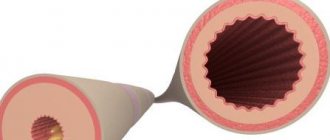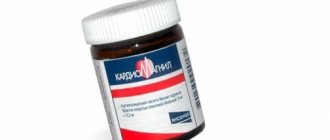Indications for use
Losek in MAPS tablets is prescribed (both separately and as part of a drug complex) for the following indications:
peptic ulcer (PU) of the stomach and duodenum, including those caused by stress or taking medications;- Barrett's syndrome, esophagitis, including reflux esophagitis with reflux of duodenal or stomach contents into the esophagus;
- Zollinger-Ellison syndrome (ZES), gastrinoma;
- heartburn, chronic and acute gastritis against the background of increased acidity;
- other acid-dependent and Helicobacter pylori-related diseases.
In the form of a solution for intravenous administration, Losek is used as part of the treatment of bleeding pyloroduodenal (perforated) ulcers, as well as in cases where oral administration of Losek is difficult: for example, when the patient is unconscious or vomiting of various etiologies.
Sometimes it is possible to do without a dropper by replacing Losek with a combined antisecretory drug - Omez D. In addition to omeprazole, it contains an antiemetic - domperidone.
As a concomitant drug, Losek can be prescribed for the treatment of osteoarthrosis, osteochondrosis and other diseases that require the use of non-steroidal anti-inflammatory drugs.
Mode of application
intravenously by drip infusion (duration – 20-30 minutes). On average, the therapeutic dosage is 40 mg/day; for patients with a rare diagnosis of ZES – 60 mg/day. As prescribed by the doctor, the dose can be increased, but then its administration must be divided into 2 procedures. The course of treatment for ulcer bleeding is about 10 days, therapy is successful in 80-90% of cases.
Losek tablets are taken orally before meals, without chewing, with a small amount of water at room temperature:
- therapeutic dose – 20-40 mg/day, in patients with ZES – up to 120 mg/day (depending on the severity of the condition);
- prophylactic (anti-relapse) dose – 10-20 mg/day.
In patients with liver failure or a history of serious liver disease, the daily dose of Losek cannot exceed 20 mg.
The duration of treatment is determined by a gastroenterologist : usually it is 14-21, less often – 7 days, but if necessary, the drug can be prescribed even for life (of course, if the patient does not feel any side effects).
Overdose
The antisecretory function of omeprazole directly depends on the dosage . When taking disproportionate doses of the drug, the secretion of hydrochloric acid can be almost completely suppressed, and its main functions will be inhibited:
antibacterial protection;- creating an optimal environment for the action of enzymes (digestive enzymes);
- denaturation of protein foods;
- stimulation of pancreatic secretion;
- regulation of motility of the lower stomach.
It is even more dangerous to take Losek without measuring acidity (pH-metry), on the recommendation of a neighbor who “helped well.” The acidity of gastric juice is an individual characteristic, and for you, unlike your neighbor, it may already be underestimated.
In addition to digestive disorders (and their manifestations in the form of vomiting, diarrhea, flatulence, etc.), an overdose of Losek may result in tachycardia, headaches , and even prolonged apathy. Treatment of clinical signs of intoxication is symptomatic; hemodialysis is not effective.
Drug interactions
The influence of Losek on the pharmacological action of other medications:
Slows down and weakens the effect of drugs, the absorption of which depends on the level of gastric acidity: in particular, antifungal (itraconazole, ketoconazole) and antiretroviral (atazanavir, viracept) drugs, as well as antianemic drugs based on ferrous sulfate (ferroplex, tardiferon, etc.)
When used together with digoxin, the bioavailability of this cardiotonic by 10-30%.
In some cases, the antithrombotic effect of clopidogrel worsens. (The mechanism of influence is associated with the participation of cytochrome CYP2C19 in the metabolism and has not yet been thoroughly studied.) If it is necessary to take clopidogrel together with a PPI, omeprazole is recommended to be replaced with pantoprazole.
Increases plasma concentration, thereby enhancing the effect
- sleeping pills (diazepam, triazolam, etc.);
- coumarin anticoagulants and other antithrombotic agents (cilostazol, etc.);
- phenytoin – an anticonvulsant and antiarrhythmic drug;
- drugs for artificial suppression of immunity (for example, during transplantation) - tacrolimus and methotrexate.
Interaction with another immunosuppressive drug, cyclosporine, in rare cases can result in either an increase or a decrease in its concentration.
It is important that when Losek interacts with clarithromycin, there is a mutual increase in concentration and an extension of the drug elimination period.
Contraindications
Losek, like other PPIs, is not prescribed to patients with individual intolerance to benzimidazoles or in cases of suspected malignancy (malignancy) of an ulcer.
In the Russian Federation and Ukraine, pregnancy is not considered a contraindication for treatment with Losek. However, in 2010 A study was published in the Journal of the American Gastroenterological Association confirming the likelihood of a delayed effect of omeprazole on the fetus. It has been shown that taking omeprazole in the first trimester of pregnancy doubles the risk of a child developing heart disease .
It is known that Losek is excreted in breast milk , but it is believed that such an amount is not capable of affecting the vital systems of the child’s body.
Due to attention-impairing side effects, Losek is prescribed with caution to people operating complex machinery.
Pharmacodynamics and pharmacokinetics
The medicine is an antiulcer agent. It inhibits the action of H + -K + -ATPase in gastric parietal cells . Thus, the last stage of hydrochloric acid formation is blocked. The effect of the medicine depends on the dose. It effectively inhibits basal and stimulated secretions when used daily.
The drug reaches maximum effectiveness within 4 days. Its action in combination with antibacterial agents causes eradication of Helicobacter pylori . Due to this, the manifestations of the disease are stopped, stable remission is achieved, damage to the gastric mucosa is healed, and the risk of bleeding from the gastrointestinal tract is reduced. When using Losek Maps there is no need for long-term antiulcer therapy.
The tablets are absorbed in the small intestine. Absorption is completed 3-6 hours after consumption. When taking the product again, bioavailability increases to 60%. Eating has no effect on it. Plasma protein binding is approximately 95%.
The half-life from blood plasma is less than an hour. The active substance of the drug is completely broken down by the cytochrome , mainly in the liver. 80% of the drug is excreted in the form of metabolites in the urine, and another 20% in the feces.
Side effects
With long-term use (and Losek can be prescribed for life), the drug can provoke the development of hidden pathological processes. The table lists the possible side effects of Losec (omeprazole) on various body systems.
- Digestive system: defects in taste perception, decreased salivation, stomatitis, vomiting, nausea, stool disorders, intestinal candidiasis, flatulence
- Hepatobiliary system: dysfunction of the liver, intensification of the activity of liver transaminases, rarely - hepatitis, hepatic encephalopathy (neuropsychiatric syndrome due to damage to liver cells)
- General metabolism: rarely - hyponatremia (low concentration of sodium ions in plasma), in exceptional cases - hypomagnesemia
- Hematopoietic system: decrease in the number of platelets or leukocytes, pancytopenia (sharp decrease in the number of all blood cells)
- Mentality and nervous system: headache, drowsiness, dizziness, apathy or agitation, very rarely - unmotivated aggression, confusion and hallucinations
- Immune system: rash, erythema, swelling, anaphylactic phenomena; very rarely – autoimmune myasthenia gravis (pathological muscle fatigue, in particular, ocular and chewing muscles)
- Urinary and endocrine systems: inflammation of the interstitial tissue of the kidneys; very rarely - mammary hypertrophy in men
During treatment with Losek, blurred vision, muscle or joint pain, increased sweating and swelling are also possible. These symptoms are usually reversible and disappear soon after discontinuation of the drug.
Interaction
The combination of Losec Maps and Ketoconazole may lead to a decrease in the degree of absorption of the latter.
In addition, the drug may increase the elimination time of Warfarin , Phenytoin and Diazepam . Therefore, dosage adjustments may be necessary. But daily use of 20 mg Losec Maps does not affect the level of Phenytoin in the blood plasma during long-term therapy, and also does not change the coagulation during long-term use of Warfarin .
The combined use of omeprazole and Clarithromycin causes an increase in their plasma concentrations.
Storage conditions
MAPS tablets - 3 years in a dry, dark place, away from children.
A bottle of d/in powder in the original packaging – 2 years at a temperature not exceeding 25◦C.
Ready solution with 5% dextrose - 6 hours, with 0.9% sodium chloride solution - 12 hours.
Other solvents for the intravenous form of Losek are not used, because it is possible that the stability of omeprazole as a chemical compound may decrease.
Price
Here is a table of the cost of various dosage forms of Losek in the Russian Federation and Ukraine. Bottles with 7 MAPS tablets are unprofitable, and bottles with 28 x 40 mg are inconvenient, so they are practically not found in pharmacies.
| Losek MAPS (table) | Powder d/in 40 mg | ||||
| 14 pcs. | 28 pcs. | ||||
| 10 mg | 20 mg | 20 mg | 1 fl. | 5 fl. | |
| Russia (price in rub.) | 190-310 | 235-380 | 515-590 | 420-520 | 1920-2040 |
| Ukraine (in UAH) | 180-240 | 240-255 | 460-515 | 280-330 | 1350-1750 |
Losek MAPS
Active substance:
Omeprazole*
Pharmgroup:
Proton pump inhibitors
Average price in pharmacies
| Name | Manufacturer | average price |
| Losek maps 0.02 n28 tablet p/cap/coating | ASTRAZENECA PHARMACEUTICALS | 562.00 |
Analogs for the active substance:Vero-Omeprazole Gastrozol Demeprazole Zerocide Zolser Chrismel Losek Omez Omez Insta Omezol Omecaps Omeprazole Omeprazole Sandoz Omeprazole-AKOS Omeprazole-Acri Omeprazole-Richter Omeprazole-FPO Omeprus Omefez Omizak Omipix Omitox Orthanol Ocid Pepticum Pleom-20 Promez Romesek Ulzol Ulkozol Ultop Helicid Helol Cisagast | Application area:Ulcerogenic pancreatic adenoma Biliary reflux esophagitis Pain syndrome in duodenal ulcer Pain syndrome with gastric ulcer Pain syndrome in gastric and duodenal ulcers Pain syndrome in gastric and duodenal ulcers Inflammation of the gastric mucosa Inflammation of the gastrointestinal mucosa Gastrinoma Gastrinomas Gastroesophageal reflux disease Gastrocardiac syndrome Gastroesophageal reflux disease Hyperacid dyspepsia Putrid dyspepsia Discomfort in the stomach area Dyspepsia Dyspepsia Dyspepsia of nervous origin Dyspepsia in pregnant women Fermentative dyspepsia Putrefactive dyspepsia Drug-induced dyspepsia Dyspepsia caused by diseases of the gastrointestinal tract Dyspepsia caused by impaired gastrointestinal motility Dyspepsia caused by unusual foods or overeating Dyspeptic symptoms during pregnancy Dyspeptic syndrome Dyspeptic disorder Benign gastric ulcer Gastric dyspepsia Gastroesophageal reflux Disease of the stomach and duodenum associated with Helicobacter pylori Disease of the stomach and duodenum associated with Helicobacter pylori Delayed gastric emptying Slow digestion Zollinger-Ellison syndrome Idiopathic dyspepsia Acid dyspepsia Drug-induced gastrointestinal ulcer Drug-induced ulcers Upper gastrointestinal motility disorder Indigestion Nervous dyspepsia Nonerosive reflux disease Non-ulcer dyspepsia Exacerbation of gastroduodenitis against the background of peptic ulcer Exacerbation of peptic ulcer Exacerbation of peptic ulcer Exacerbation of duodenal ulcer Exacerbation of gastric ulcer Organic gastrointestinal disease Complications of peptic ulcer Acute stress ulcer of the gastrointestinal tract Feeling of heaviness in the stomach after eating Peptic ulcer of the stomach and duodenum Peptic ulcer of the stomach and duodenum Peptic ulcer of the gastrointestinal tract Peptic ulcer with Helicobacter pylori Peptic ulcers Perforation in peptic ulcer Damage to the gastrointestinal mucosa caused by NSAIDs Postoperative gastric ulcer Postprandial functional dyspepsia Fermentation processes in the intestines Stomach upsets Gastrointestinal disorders Digestive disorders Gastrointestinal disorders Stomach upset Digestive disorder Digestive disorders in infants Ulcer recurrence Recurrence of duodenal ulcer Symptomatic gastrointestinal ulcer Symptomatic stomach ulcers Symptomatic ulcers of the stomach and duodenum Symptomatic ulcers of the stomach and duodenum Symptomatic gastrointestinal ulcers Symptoms of dyspepsia Gastrocardiac syndrome Putrid dyspepsia syndrome Putrefactive dyspepsia syndrome in young children Digestive insufficiency syndrome Non-ulcer dyspepsia syndrome Roemheld syndrome Stress ulcer Stress stomach ulcer Stress damage to the mucous membrane Stress damage to the mucous membrane Stress ulcers Duodenal stress ulcers Stress stomach ulcers Stress ulcers of the gastrointestinal tract Toxic dyspepsia Functional dyspepsia Functional digestive disorders Chronic dyspepsia |
Analogs
More than 4 dozen trade names of omeprazole-containing drugs are registered in the Russian Federation. In Ukrainian pharmacies you can also buy Swiss Gasec and 4-5 Omeprazoles from various local pharmaceutical plants. So, Losek’s analogues are:
- drugs with complex names containing the word Omeprazole (Omeprazole-Acri, etc.);
- Omez, as well as Omez Insta and Omez-D with additional components in the composition;
- Omezol, Omeprus and other drugs consonant with them;
- Gastrozol, Demeprazole, Zolser, Zhelkizol, Ortanol, Pepticum, Romesec, Ulkozol, Cisagast, Helicid, Helol, etc.
Video on the topic: Heartburn, reflux - causes and treatment
Reviews
According to patient reviews, Losek is a fairly effective drug with a complex nature. (This is another argument in favor of taking it only with the consent of your doctor.)
Let us list theses that summarize the available information about the effectiveness and tolerability of Losek.
- The effect of oral administration is noticeable within 2-4 days; Patients note almost complete attenuation of symptoms and heartburn on the 5-7th day. The frequency of relapses after a course of treatment with Losek is low: many people forget about diseases that previously seemed chronic for decades.
- Drinking Losek occasionally, as an emergency aid for stomach pain, is irrational. There are complaints that 10-15 hours after taking the pill, which helped initially, the “rhythm” of gastric juice production is disrupted: acidity (according to subjective sensations) increases more than before taking the drug.
- Lyophilisate for drip administration is well tolerated by the body, without obsessive side effects. Persistent improvement in the patient's condition with intravenous administration of Losek occurs approximately on the 5th day.
- The most common side effects are migraine, nausea, weakness and dizziness. There are also reports of severe visual impairment. Many of the patients whose intensity of side effects were tolerable managed without stopping the drug: after 2-4 days of the adaptation period, the adverse effects disappeared on their own.
Reviews from our readers about the drug Losek are given below, after the final section.




